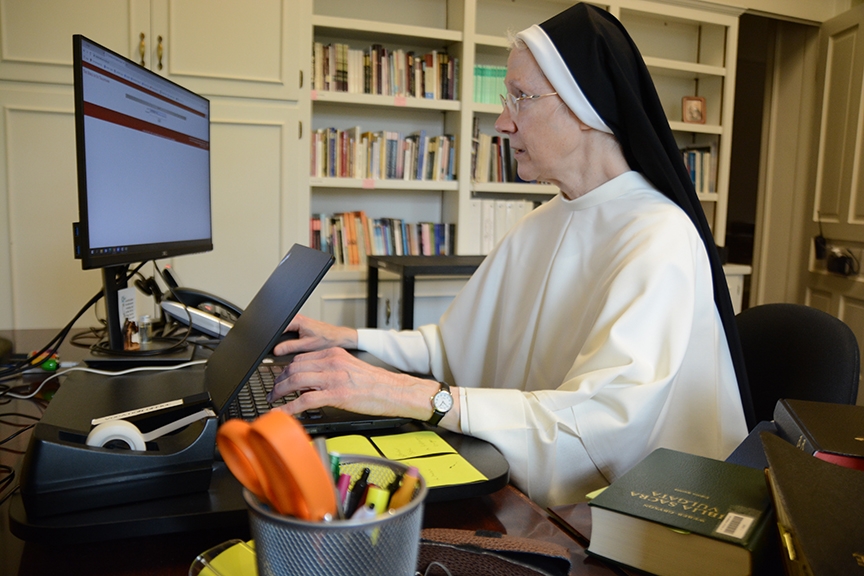
For the past five years, Sister Mary Dominic Pitts, O.P., has been deep in study of the Book of Revelation as she and 250 others work on a new translation of the last book of the Bible in a project known as Le Bible et ses traditions, or “the Bible and its Traditions,” or BEST in French abbreviation.
The project is being sponsored by École Biblique et Archéologique Française de Jérusalem.
“École Biblique is a center of research, translation and study of Scripture and archaeology. It is best known for its publication of the Jerusalem Bible,” Sister Mary Dominic explained. “It was founded in 1890 in Jerusalem by the French Dominican priest Father Marie-Joseph Lagrange, a Scripture scholar and pioneer in Biblical exegesis. Its administration and much of its teachings are still carried on in French.”
Sister Mary Dominic had already spent two years writing notes on the Book of Revelation when Dominican Father Anthony Giambrone, vice director of École Biblique, called on her to do more in October 2019. It was up to her to translate all five original languages of the book – the Latin Vulgate, the Syriac Peshitta, and the three versions of the Greek New Testament – into English, as well as write notes on interesting grammar, words and more, Sister Mary Dominic said.
“Father Giambrone stressed the fact that they ‘needed a linguist’ to comment on the language-related aspects of the project. I think that my ‘skill set’ with a doctorate in linguistics and in-depth study of the analysis of languages was what suggested my participation on the project,” Sister Mary Dominic said. “It helps that I am an experienced editor, which helps keep the footnotes well written but short.”
Sister Mary Dominic’s knowledge of the three languages came from years of study. In 2001, she studied Syriac with one of the world’s experts in the language, Father Stephen Ryan, OP, during a summer course at Providence College in Rhode Island.
“That was an accidental acquisition,” Sister Mary Dominic said. “I signed up just for fun, never guessing that I would actually use it 16 years later.”
She learned Greek at Providence College as well, a requirement for her master’s degree in Biblical Studies.
“I’ve tried to keep it up since then,” she said. “I have good dictionaries and grammar (books) to work with all these languages.”
She has been studying Latin since high school and she continued her studies during her time at the convent with the Dominican Sisters of St. Cecilia Congregation in Nashville.
With her experience in studying languages, Sister Mary Dominic said, she spends roughly a month per chapter.
“I translate them myself a verse at a time from all five versions to insert into the BEST platform in English. The texts that I translate are the original ancient languages in their own spellings and alphabets,” Sister Mary Dominic said. “Any significant variants are ‘stacked’ vertically in the text over the word or phrase where they actually occur, one language on top of another for ease of comparison.
“The five versions are translated as literally as possible to ‘stay true to the text’ especially from Syriac, a language not known as well as Greek or Latin,” she explained.
One such example is of Revelation 1:1:
“The Revelation of Jesus, which God gave him to show/ V make public to his servants the things which must come to pass quickly/ S soon to his servant Ionnes/ S Yuhanon.”
“The actual program aligns the alternatives – here separated by a slash – one on top of the other,” she explained. “The small superscript ‘V’ signals a variant in the Vulgate, and the ‘S’ in the Syriac.”
With the translation comes extensive footnotes at the foot of each chapter, she added.
“They are keyed to cover the verses and cover many linguistic and socio-cultural facts never before commented on, including grammatical features, derivations and meanings of words, figures of speech, historical or other contextual facts, and Jewish and Christian tradition,” Sister Mary Dominic said. “The BEST home page expresses well the purpose and quality of the notes: ‘We intend to create the most extensive and helpful set of notes for the entire Bible, with information of interest both to biblical scholars and casual readers.’”
One such example of a footnote is as follows:
“There is a difference in the use of the word “crown,” also worn by martyrs, and “diadem,” worn to show royalty (Rev. 19:12) or pretended royalty, on the seven heads of the dragon (Rev. 12:3).
As she continues to work on the translations, Sister Mary Dominic said, she expects to complete the project by mid-fall and has high hopes for its contribution to the Church and its people.
“Pope Leo XIII and Pope Pius XII issued encyclicals inviting modern study of the Bible so that Scriptures would be opened up to the faithful in the same methods that Father Lagrange pioneered at the École Biblique,” Sister Mary Dominic said. “The BEST approach contributes to the richness of Scripture in, for example, ‘biblical polyphony’ resulting from the different versions and will restore the Catholic feel and appreciation of God’s many voices in Scripture.
“There is the unique Jewish flavor of Old Testament translations. For example, Psalm 62:11: ‘God spoke once and I heard twice,’” she said. “Finally, BEST conveys an extensive ‘reception history’: as soon as the divine Word touches human culture, it yields creativity and radiates many forms.”
For more information about BEST and the project, visit https://www.ebaf.edu/project-best-2/.









